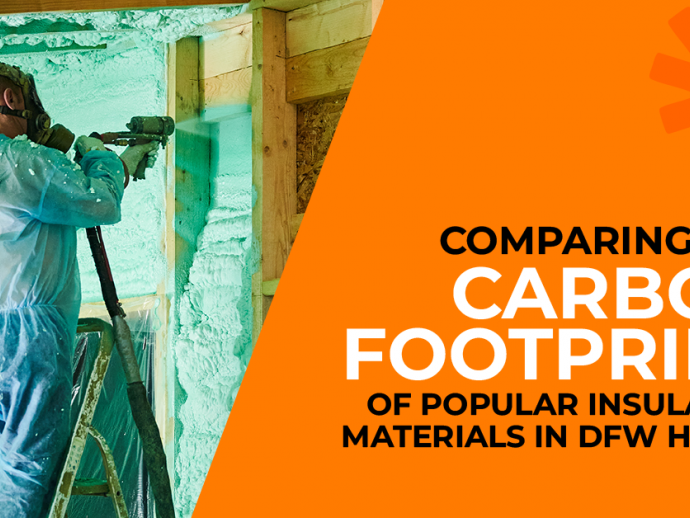Comparing the Carbon Footprint of Popular Insulation Materials in DFW Homes

When you think about making your home in the DFW area more energy-efficient, insulation is often one of the first things to consider. But here's something many homeowners overlook: not all insulation is created equal—especially when it comes to environmental impact.
If you’re curious about how much energy your insulation saves, great. But have you ever thought about how much energy it costs to make? That’s where the carbon footprint comes in. In this post, we’ll break down what that means, how different types of insulation stack up, and how to make a smarter, more sustainable choice for your home—without the headache.
What Is a Carbon Footprint (and Why Should You Care)?
A carbon footprint is the total amount of greenhouse gases (mainly CO2) produced by an activity or product—like manufacturing insulation. This includes:
-
Raw material extraction
-
Production and processing
-
Transportation
-
Installation
-
End-of-life disposal or recycling
According to the U.S. Department of Energy, buildings account for nearly 40% of all carbon emissions in the U.S.—and insulation can play a major role in reducing that number.
A lower carbon footprint means less environmental damage, which can also mean a smarter long-term investment when you're thinking sustainability + ROI.
Why Insulation Matters for Sustainability in the DFW Area
Good insulation reduces your home's energy use for heating and cooling, which means fewer emissions over time. That’s especially important in North Texas, where extreme summer heat can send energy bills skyrocketing.
The type of insulation you choose plays a big role in how green your upgrade really is. The trick is finding insulation that balances low embodied carbon (the carbon released during its production) with operational savings (how much energy it helps you save over time).
Comparing Insulation Types by Carbon Footprint
Here’s a closer look at some common insulation options used in homes across Dallas-Fort Worth and surrounding suburbs. Each table breaks down the pros, cons, materials, and carbon impact.
1. Fiberglass Insulation
|
Attribute |
Details |
|
Material |
Sand and recycled glass |
|
Pros |
Affordable, widely available, fire-resistant |
|
Cons |
High embodied energy, potential skin/respiratory irritation |
|
Carbon Footprint |
Medium to high |
|
Notes |
According to the National Renewable Energy Laboratory, fiberglass requires large amounts of heat to produce. |
2. Spray Foam Insulation (Polyurethane)
|
Attribute |
Details |
|
Material |
Petroleum-based chemicals |
|
Pros |
High R-value per inch, excellent air sealing |
|
Cons |
Not recyclable, high global warming potential (GWP) |
|
Carbon Footprint |
Very high |
|
Notes |
Per the Environmental Protection Agency (EPA), spray foam releases potent greenhouse gases during application. |
3. Cellulose Insulation
|
Attribute |
Details |
|
Material |
Recycled newspaper or cardboard |
|
Pros |
Very low embodied carbon, affordable, biodegradable |
|
Cons |
May settle over time, needs fire retardant treatment |
|
Carbon Footprint |
Very low |
|
Notes |
The International Association for Energy-Efficient Insulation ranks cellulose as one of the most eco-friendly options available. |
4. Mineral Wool (Rock Wool or Slag Wool)
|
Attribute |
Details |
|
Material |
Volcanic rock or steel production byproducts |
|
Pros |
Moisture- and fire-resistant, soundproofing properties |
|
Cons |
Energy-intensive production |
|
Carbon Footprint |
Medium to high |
|
Notes |
Though it uses waste materials, the high processing heat raises its environmental impact. |
5. Cotton (Recycled Denim)
|
Attribute |
Details |
|
Material |
Recycled jeans and cotton scraps |
|
Pros |
Safe to handle, natural, good acoustic performance |
|
Cons |
More expensive, can need added treatments |
|
Carbon Footprint |
Low |
|
Notes |
Cotton insulation is an upcycled product, reducing textile waste in landfills. |
Lifecycle vs. Performance: What Really Matters?
Some materials, like spray foam, have a high carbon cost to produce but may save more energy in the long run. Others, like cellulose, are green from the start but may require more attention during installation.
What should you prioritize?
-
For maximum energy savings in DFW’s summer heat, foam and fiberglass perform well.
-
For lower environmental impact, cellulose, wool, and denim win out.
The best choice is often a mix—something that delivers savings now and keeps emissions low over time.
How to Choose Sustainable Insulation in DFW Homes
When you're comparing insulation for your Dallas-Fort Worth home, look beyond just the R-value. Consider:
-
Embodied carbon: Check for Environmental Product Declarations (EPDs)
-
Recycled content: Higher percentages = better
-
Certifications: GREENGUARD, Cradle to Cradle, etc.
-
Climate compatibility: Choose materials that perform in DFW’s humid, hot climate
-
Sealing and ventilation: Insulation alone won’t work without a tight envelope
Final Thoughts: Small Change, Big Impact
Choosing the right insulation is more than just comfort—it's about cutting costs and protecting the planet. When you think about how insulation is made, how long it lasts, and how well it performs in DFW’s climate, you’ll make smarter choices that support your budget and the environment.
If you’re ready to upgrade, explore our directory of sustainable insulation contractors serving the Dallas-Fort Worth area and nearby communities.
